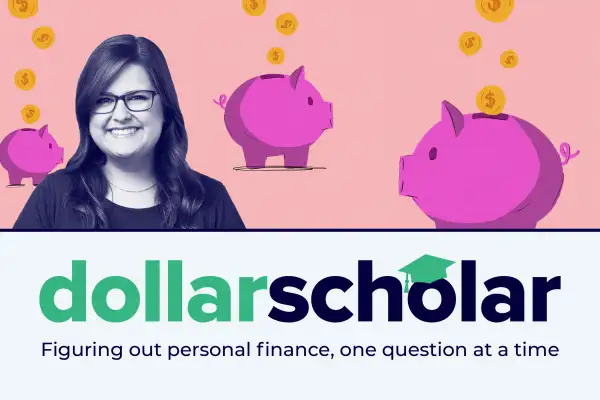Dollar Scholar Asks: How High Can High-Yield Savings Rates Go?

This is an excerpt from Dollar Scholar, the Money newsletter where news editor Julia Glum teaches you the modern money lessons you NEED to know. Don't miss the next issue! Sign up at money.com/subscribe and join our community of 160,000+ Scholars.
I never know what I’m going to get when I open up my email inbox.
Half of the time, it’s good news — my Amazon package shipped! Emo Night Brooklyn announced a new show! My grandma is saying hi! But the other half of the time, it’s not so great — I’m overdue for a dental cleaning! My electricity bill needs to be paid! Holiday flight prices just increased!
Ugh.
Over the past few years, I’ve gotten accustomed to mentally filing any communications from Ally, my online bank, into the second category. The emails were almost always alerts that Ally was dropping the interest rate on my high-yield savings account. The economic environment was to blame, but it still sucked.
That changed on May 10. Ally emailed me to announce it was raising the annual percentage yield, or APY, from 0.5% to 0.6% for all balance tiers. It was the first time Ally’s APY had increased since January 2019.
Shocked, I wrote it off as a fluke. But it happened again on May 26. And again on June 9. And several more times after that, ultimately reaching 2.35% this week.
In its most recent email, Ally linked the rate hike to recent trends, market conditions and other factors, adding that it's "part of our commitment to deliver competitive rates." But Ally isn’t the only online bank bumping up its rates; Marcus (currently at 2.35%), Synchrony (2.45%) and others have been jacking their APYs, as well.
Just how high will high-yield savings rates go?
Laura Cuber, a certified financial planner with Bartlett Wealth Management, says online banks generally are able to offer enticing interest rates because, unlike brick-and-mortar institutions, they don’t have to pay overhead costs. They use high rates as a way to attract customers, which is a lot harder without a physical location and/or legacy brand.
Late 2018 and early 2019 amounted to a golden age for online banks. The economy was good, and they were competing so fiercely with each other that they pushed rates over 2%. Then the Federal Reserve lowered its rates in mid-2019, coronavirus hit in 2020, and all of that growth was undone.
The rebound we’re seeing now has to do with the Federal Reserve, as well. The nation’s central banking system is attempting to cool down inflation by raising the federal funds rate.
“The federal funds rate controls how much it costs to borrow money in this country, and when it is higher, banks can make more money by loaning out their customers’ deposits at higher rates,” Cuber says in an email interview. “In turn, they offer higher interest rates to their customers to encourage them to keep their deposits at the bank.”
The Fed has now hiked rates five times in 2022. As I write this, the target federal funds rate is 3% to 3.25%.
Faron Daugs, a CFP with Harrison Wallace Financial Group, says the Fed’s hope is that by making it cost more to borrow money, people will want to borrow less. Fewer dollars chasing limited goods equals lower prices... and higher APYs.
Increases to online savings account rates always lag behind the Fed’s rate hikes. But when one online institution boosts its savings rates, it kicks off a chain reaction, putting “pressure on other banks to follow suit because they don't want to lose customers,” he adds.
How high rates will climb depends on how high inflation gets and how aggressive the Fed wants to be, according to Joel Kiskila, senior director of cash management operations for Personal Capital.
Cuber says there’s no cap, but she’d “be surprised if we reached double-digit rates.” The last time the U.S. had savings account yields on that level was in the ‘80s, when inflation peaked at 13.6%. Obviously there were no online banks at that time, but in December 1981 the average three-month yield on certificates of deposit (a type of savings account) hit 18.65%, according to the St. Louis Fed.
That rate has been under 10% since March 1989. And obviously, even our way-greater-than-normal inflation rates are nowhere near 13.6%.
More specifically, Daugs predicts that if the federal funds rate reaches 4%, we might see high-yield savings rates reach 3%.
For me, that means my savings are working harder than normal. Kiskila says online banks’ high-yield savings accounts are good in that they offer FDIC insurance, high liquidity and convenience for free.
The downside? They’re not keeping pace with inflation, meaning that I’m losing purchasing power over time. Cuber says that I should make sure I have enough liquid savings for a healthy emergency fund, but I may also want to consider investing some of my money to make sure I can maintain my desired standard of living.
The bottom line
Online banks are raising APYs on their high-yield savings offerings in reaction to moves by the Fed. Rates will likely keep going up for now, but they’re going to top out soon... and likely well below 10%.
“Higher rates often mean not-so-good news for borrowers,” Kiskila says. “But for savers, this is a good time to save your money.”
More from Money:
Am I Keeping Too Little in My Checking Account? Here's What Experts Say
